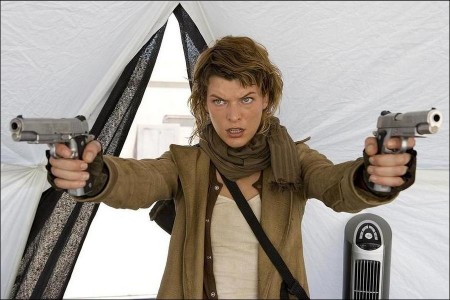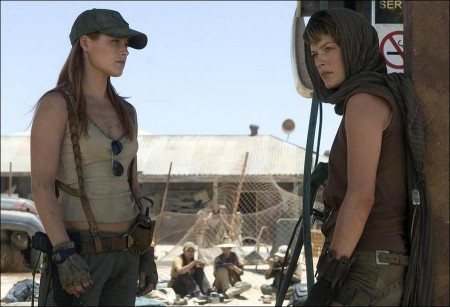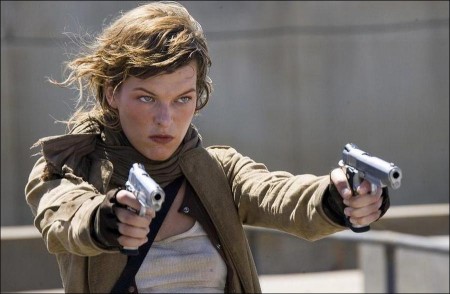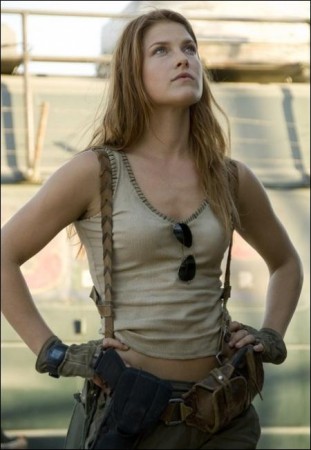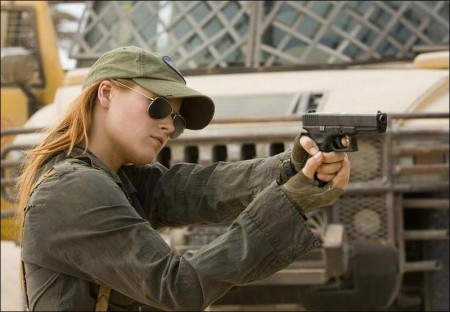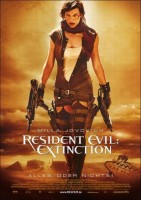It’s the end of the world… The experimental T-Virus, concocted by the Umbrella Corporation, has been unleashed on the world, transforming the population into a scourge of shambling zombies with a taste for flesh.
With no safety in the cities, Carlos Olivera (Oded Fehr) and L.J. (Mike Epps), along with new survivors Claire (Ali Larter), K-Mart (Spencer Locke) and Nurse Betty (Ashanti), have gathered a group of survivors and taken to the road… traversing the empty desert highways in an armored convoy. What they seek is more of their kind – the living… the uninfected. What they find is the other constant presence in the desert: the Undead – and they’ll need dozens of guns, thousands of bullets to protect themselves.
Hidden beneath an abandoned Nevada radio tower are the sleek offices and research facilities of the Umbrella Corporation. With access to Umbrella’s constant realtime satellite surveillance, Dr. Isaacs (Iain Glen) can keep constant tabs on the convoy… but he’s searching for the one person who not only is the key to a cure, but everything Umbrella’s experiments have been leading up to… Alice. Once held captive by the Umbrella Corporation, Alice was subjected to biogenic experimentation that left her genetically altered, giving her superhuman strengths, senses and dexterity.
Mutating by the minute, and under constant threat of betrayal by her own Umbrella-engineered DNA, Alice has been shadowing the convoy, standing by to protect them, hoping to somehow usher them to safety. The convoy decides to head north to Alaska — their last, best hope for refuge from the Undead – but first they will have to make a pit-stop in Las Vegas to refuel… and stay out of Umbrella’s sightlines if they ever hope to reach it. Not only is Umbrella looking for Alice, but she is also looking for them… and she won’t stop until they’re shut down forever. The fight is only just beginning…
Adapting Resident Evil: Extinction
The third and final installment of the $100 million Resident Evil trilogy, Resident Evil: Extinction is again based on the wildly popular video game series. The first film established the world of the Resident Evil film franchise; the second film, Resident Evil: Apocalypse, found Alice (Milla Jovovich), L.J. (Mike Epps) and a renegade Umbrella officer named Carlos Olivera escaping Raccoon City and Umbrella’s plot to extinguish them. Resident Evil: Extinction finds them loose in the Las Vegas desert, moving from place to place in an armored convoy, outrunning and outgunning the throngs of Undead that lurk in the wide, empty spaces that can no longer be called civilization.
“I think the strength of the Resident Evil movies is that they’re not just zombie movies,” says writer/producer Paul W.S. Anderson, the creative force behind the Resident Evil trilogy. “There are creatures in these films, more than just the Undead. There are also a lot of science fiction concepts in the movies, as well, so they’re bigger than just a zombie movie.”
Constantin’s Bernd Eichinger, Robert Kulzer and Martin Moszkowicz, who first envisioned the Resident Evil movie franchise, are once again reunited with Davis Films’ Samuel and Victor Hadida and Impact Pictures’ Jeremy Bolt and Paul W.S. Anderson.
“Paul has done something which is very unusual for a genre movie,” says producer Robert Kulzer. “It feels like a very epic movie, with story arcs that go across several movies and combine again and get separated again. All of these characters have taken on lives of their own. He’s so connected with this franchise, and these characters and the world of the game. I think this world really inspires his imagination.”
Taking the director reins this time is Russell Mulcahy, who started his career as a music video director before helming such seminal films as Highlander and its sequel, as well as The Shadow and Ricochet. “For my generation of filmmakers, Highlander was a big thing,” says Anderson. “Russell pioneered a very distinct visual style, a lot of moving camera and crane work, lots of very fast cutting. He’s got a very cool eye and sees great ways to shoot. His work certainly had a big influence on me as a filmmaker and that’s why I was very excited to work with him on this movie.”
“When we had our first meeting with Russell, he literally came in with a book,” recalls Kulzer. “He had storyboarded the entire movie, and he took us through it – shot by shot, scene by scene. We were just blown away by this.”
“Horror films have always been a great passion of mine, so it’s great to get my hands on such a fantastic script,” says Mulcahy. “Visually, Resident Evil: Extinction is different from the previous two films. The first one was quite claustrophobic; the next one was outside on wet night streets, and now, we take them out into the desert. It has a very western feel but is futuristic, crazy and creepy.”
“We took a lot of inspiration from another genre of films that I grew up with, which is the post-apocalyptic movie, of course, Mad Max and The Road Warrior being the best of them,” Anderson adds. “There’s a whole audience of people who don’t know how cool seeing armored trucks blast through these desert landscapes can be.”
Where the first two films unfolded in tight, contained spaces, the third film’s large scale action sequences take place amid post-apocalyptic landscapes in broad daylight. “What’s terrifying is not necessarily that which goes bump in the night, but that which whispers at mid-day,” says Mulcahy. “In some ways it’s even more terrifying. We do have our dark, spooky scenes, but we have a wonderful visual contrast of this blasted sand and stormy desert landscape, such as Las Vegas covered in sand. And then you go underground to the Umbrella Corporation, which is all blue and cold and steel. It’s quite a refreshing and surprising look, a very visceral look, without taking away any elements of the game, which is very important. We’ve been very adamant about keeping true to the spirit of the game.”
As with the previous Resident Evil films, Extinction resonates with the contemporary zeitgeist. “In this movie it’s very much about the shortage of oil, the shortage of supplies, and how the desert has taken over civilized land,” notes Kulzer. “Even though it’s a science fiction action film, there are nuances about it that reflect the world we know, the one we live in right now.”
Resident Evil: Extinction is an original story, but one that unfolds in a world that fans of the game will recognize. “It’s all part of trying to deliver a movie going experience that satisfies the fans of the game but also provides a fun cinematic experience for a broader audience that has never played a Resident Evil game,” says Anderson.
At the heart of the terror in Resident Evil are the ever-present zombies unleashed through T-Virus mutation. While the concept of the Undead remains the same, the stakes have once again been raised. “The game has progressed and broadened out, and we thought we should change as well,” explains Anderson. “So, we’ve introduced the Super Undead, which are a result of Umbrella experimenting with the Undead and attempting to give them back some of their reasoning power, some of their intelligence and a little of their humanity. Unfortunately, these experiments don’t quite work and the side effect is the Super Undead, which are Undead that are faster, stronger and more cunning… a really fearsome foe.”
But mindless flesh-eaters aren’t the only predators the characters have to fend off. “We’ve also included the Tyrant, which is a big favorite of a lot of fans of the game,” says Anderson. “It’s certainly one of my favorite creatures from the game. And we’ve brought back some old favorites, like the dogs. We’re using the crows properly for the very first time – there’s an amazing sequence that has these mutated crows in it.”
While sticking to the spirit of the games, Anderson has injected the story with fresh concepts and Mulcahy has brought the whole enterprise into the light. “To simply copy the games would not be a good movie going experience because you would know exactly what’s going to happen and which characters would live and die,” Anderson notes. “That’s one of the big challenges: to stay true to the games but also break the rules a little bit.”
Humans Vs. Undead: About the Story
Resident Evil: Extinction picks up three years after the second film ended. “It’s set in the desert, so there are very few buildings, very few people,” comments producer Jeremy Bolt. “It has an atmosphere of isolation and desolation. What’s most striking about these landscapes is that there’s just nothing there three years after the apocalypse, apart from our band of survivors, and the evil Umbrella Corporation.”
“The third movie is set pretty much after the end of the world,” says Anderson. “The world has been wiped out by the T-Virus and only a small microcosm of humanity is left. It’s kind of the proto-family of the future – this band of survivors who are part of an armored convoy that stays on the move continually, to try to stay out of trouble and stay ahead of the Undead.”
Some of the survivors have now formed a group of roughly thirty people, including adults and children, transported by a convoy of vehicles, “which includes a school bus, an ambulance, a news truck and a gas tanker,” Mulcahy describes. “They basically go from town to destroyed town trying to find food and water, and just to keep surviving. But they’re getting desperate.”
Acclaimed actress and one of cinema’s foremost female action stars, Milla Jovovich once again reprises the role of Alice, an experiment of the Umbrella Corporation whose DNA bonded with the T-Virus, giving her unprecedented power and independence. Since her escape from The Hive and Raccoon City, Alice now answers only to her will to survive and protect the last vestiges of humanity. “They’re desperate, and Alice hears radio broadcasts of people in distress, but she keeps her distance. Her thought is that whenever she’s near people, people die. So, she’s got this standoffish quality about her.”
“Alice, since the last film, has definitely changed,” Jovovich explains. “She’s a loner now. She doesn’t really know what is going on with these new powers and weird things keep happening to her. If she falls asleep and has a nightmare, things start exploding. It’s pretty crazy.” Afraid that her mutations and genetic link to Umbrella will be a liability to the human survivors she wants to protect, Alice shadows them undetected through the desert.
“It’s a pretty lonely position,” says Jovovich. “She doesn’t have anybody to lean on; she’s very much by herself. She’s definitely a bit sad, but at the same time, she’s got a mission and her priority is to make sure that these people are safe, and hopefully try and take down Umbrella at the same time.”
“Umbrella is using her and she knows it,” adds Anderson. “She knows that Umbrella has been tracking her and can potentially see through her eyes, and use her as a spy. So, she has isolated herself and stayed away from the others. She also knows that she’s infected with the T-Virus and it’s causing mutations within her. She’s developing new powers, which we saw at the end of the second movie, but they have become much greater now and are out of her control, so she’s terrified of what she can do. She stays away from the others because she’s scared that she may cause them harm.”
Jovovich’s evolution in the skin of the Alice character has formed the heart of all the movies. “We put Milla through an awful lot in these films,” says Anderson, “and she always has a good sense of humor about it and always delivers. One of the things that makes the action scenes good in Resident Evil is her intention; you see it in her face, she believes everything. That’s really important in a movie like this because you can only believe the horror, and you can only believe the action if the actor does. If she’s terrified, so is the audience. And that’s what Milla gives these movies – she gives a hundred and ten percent commitment.”
The convoy is a family, led by Claire Redfield, a character from the game. “She’s basically the general, leading the pack,” says Mulcahy. At the core of the Resident Evil films are strong female action heroes, and Claire is no exception. To embody a figure that would have the strength and compassion to lead a pack of survivors, the filmmaker brought in Ali Larter, the central figure in the blockbuster Final Destination series and one of the human superheroes in the hit TV series, Heroes. “She’s a very committed actress,” says Anderson. “She gives a great performance and knows how to handle a gun. I’ve really enjoyed working with her.”
“Claire Redfield is the leader of the convoy making its way across the Nevada desert,” describes Larter. “They travel in a chain of trucks – an ambulance, a Hummer, a gas truck, a bus where people sleep. Everybody’s just holding on. You can’t stop for too long. The only things that matter are the basic things you need to survive: food, gas, water, weapons. So, they’re just in a constant state of motion, trying to stay alive.”
In addition to being the leader, Claire assumes different roles for the survivors in her convoy, all of whom have lost family, friends and the lives they knew. “She’ll be a mother to someone, a best friend, a buddy, anything that her people need,” Larter explains. “We’re at the end of the earth and she’s just trying to be a guiding force to these people.”
When Alice is driven to join Claire’s convoy, she steps into a world in which Claire is the leader and Alice is only a spectator. “At first people are apprehensive,” says Anderson. “There are scenes where people like take one look at Alice, when she’s wandering in the camp, and start wondering whether she’s this devil woman. A line in the script says, ‘The kids talk about you like you’re Dracula or something.’ Everyone takes a step back at first.”
Returning from the second film is Carlos Olivera, played by Oded Fehr. “Carlos was very much a corporate guy,” explains Kulzer. “He was part of the Umbrella Corporation, but at one point, he realized that Umbrella is not as good a place as he thought it was. I think he became doubtful of the morality of it when he realized that Umbrella was ultimately responsible for the demise of civilization.”
“Carlos used to work for the Umbrella Corporation as a hired gun,” says Fehr. “In the last movie, he realized what he’d been caught up in and joined forces with the good guys. So, he’s a soldier and a bit of a loner, and he’s very much in love with Alice.”
Though when the film begins, Alice and Carlos are separate, their reunion brings hidden feelings to the surface. “They have a lot of respect for each another, and this attraction,” says Jovovich. “So, when they meet again on this film, it’s a big relief for Alice. She’s so strong and so independent, but he’s the only one that understands what she’s been through. He’s not scared or intimidated by her. She doesn’t have anybody like Carlos in her life, and there is a great connection between the two of them. It was fun to play with the boundaries between these two characters.”
“The Resident Evil films, certainly the first two, are very female-driven movies,” comments Anderson. “In the second film, Oded made a big impression when he was on screen. The third movie brings him even more to the foreground, so I think for the very first time, there’s a really strong central male character in a Resident Evil movie. And Oded brings real strength and wisdom to the role.”
Also returning is L.J., played by Mike Epps, whose nature is to bring light to even the direst situation. “L.J. started out as just this fun character who knows his way around the place,” describes producer Kulzer. “Now, we pick him up again and he’s become an intricate part of this survival machine. People rely on him. He’s still a funny guy, but he’s clearly reached a point where he’s a much more responsible member of this team.”
For Epps, the opportunity to bring some realness and humanity to his character was one the actor relished. “This film is much more than your typical horror movie,” says Epps. “The characters are a lot closer in this film. There’s more emotion, and you connect with them.”
Anderson also wrote a character specifically for an actor whom he had worked with on his first American film, Mortal Kombat. Linden Ashby plays Chase. “Linden Ashby was the lead in Mortal Kombat, and I’ve wanted to work with him again ever since,” says Anderson. “He’s a cowboy – he lives on a ranch and has horses, so when I was writing this movie I brought him in as a foil for L.J., because Mike Epps is so urban, and to put him alongside Linden was perfect. The character of Chase has been a real revelation in the movie. It’s just been really fun to work with Johnny Cage again.”
The convoy also bears two young women in its ranks – Nurse Betty, played by musical artist and actress Ashanti, and a 14 year-old tough kid named K-Mart, played by up-and-coming actress Spencer Locke.
Ashanti, a fan of genre films, jumped at the chance to step into the environment of the film. “Resident Evil is about survival,” she says. “Our group is stationed in Las Vegas, which is where the survival of the fittest ended up. They’re running low on food, and they’ve picked up a lot of kids along the way. Nurse Betty is there to help anyone who gets hurt, especially if they get bit by one of the Undead. She’s definitely tough, and walks around with her bullets and her pack and band-aids. She’s all about business.”
K-Mart, says Locke, contributes a sense of hope to the people of the convoy. “KMart makes wire bracelets, which are like her good luck charm,” says the 14-year-old. “I got to pick what bracelets she makes, which was cool.”
While the survivors fight to stay alive on the surface, they must always stay on the move, searching for fuel and supplies while fending off everything from the Undead to a virulent breed of crows who have mutated by eating the infected Undead. “You go through barren landscapes to strange TV stations where they find people who are not zombies or Undeads; but they’re backwards and frightening,” describes Mulcahy. “And we have a very potent attack by the crows that is like Hitchcock notched up ten times.” But beneath the blasted desert surface is a completely different world. “The only place that is still up and running are these underground hives of Umbrella,” says Jovovich.
“You’re outside the old, beaten-down weather station, which is all caged with ten thousand Undead trying to get in,” describes Mulcahy. “And you come down to the Umbrella Corporation, which is the metal blue, where these scientists are living. So, there’s this great contrast visually of going up and down between these two worlds that exist parallel to each other.”
Running the Nevada station but subject to the authority of the Umbrella Chairman is Dr. Isaacs, a returning character once again played by Iain Glen. Dr. Isaacs is obsessed with recreating Alice from a series of clones farmed in glass tubes within the complex.
“He is responsible for trying to recover the situation because the T-Virus has wrecked the human population,” says Glen. “And he thinks he knows how to find the key to unraveling it using Alice’s blood to form an antidote. Dr. Isaacs is a very arrogant man, and when he is overruled by the powers above him, he doesn’t much like it, so he decides to go off on his own to find Alice, whom they all believe is dead.”
So, while Alice has the Undead above-ground to contend with, her most formidable foe is underground in the lab. “She’s dealing with quite a keen intelligence and he has a certain power over her,” says Glen. “He knows her well – in some ways, he created her — so it’s a different sort of enemy.”
Dodging the ever-watchful eye of the Umbrella satellites, Alice pledges her help to the convoy when they find a diary which points to a possible safe haven far north of them, in Alaska. With most of the gas stations in the desert dry as a bone, they realize their best hope lies within the sand-covered remains of Las Vegas.
But when Dr. Isaacs spots Alice among the convoy, they find themselves hopelessly in Umbrella’s sightlines and must fight their way through a new breed of Super Undead to stay alive.
“We try and play with the conventions of the genre and set up a scene that everyone’s familiar with and then pull the rug from underneath them a little bit,” Anderson explains. “I think then you can take people by surprise and deliver some really satisfying and exciting action scenes. People will be shocked at how this story plays out, and what happens to the characters they have gotten to know in these films. We wanted to keep things in the realm of the unexpected, and I think this film really delivers in turning some genre conventions upside down.”
Production notes provided by Sony ScreenGems.
Resident Evil: Extinction
Starring: Milla Jovovich, Oded Fehr, Mike Epps, Ali Larter, Chris Egan, Ashanti, Iain Glen, Sienna Guillory, Jason O’Mara
Directed by: Russell Mulcahy
Screenplay by: Paul W.S. Anderson
Release Date: September 21, 2007
MPAA Rating: R for strong horror violence throughout, some nudity.
Studio: Sony ScreenGems
Box Office Totals
Domestic: $50,648,679 (34.3%)
Foreign: $97,069,154 (65.7%)
Total: $147,717,833 (Worldwide)
